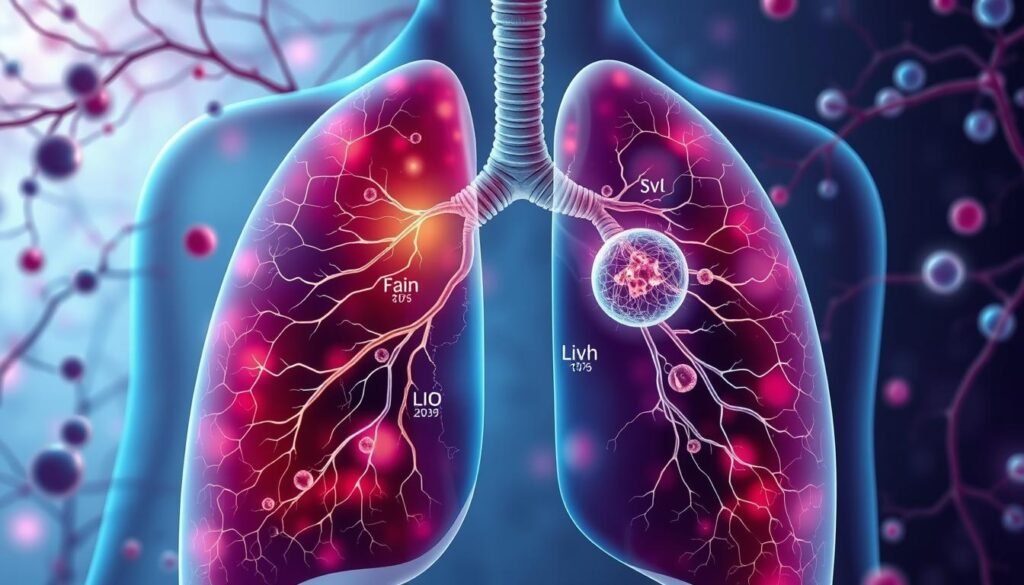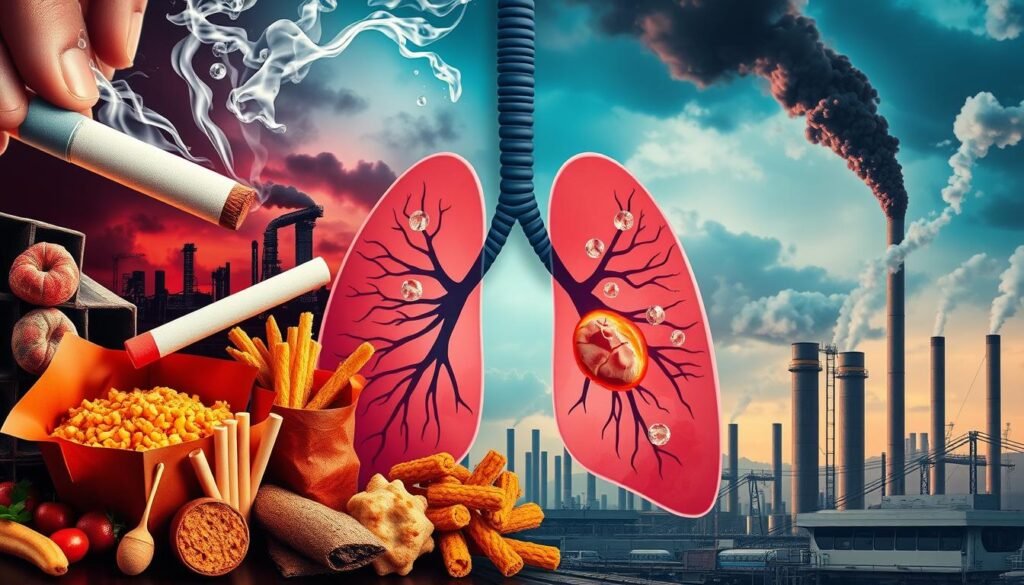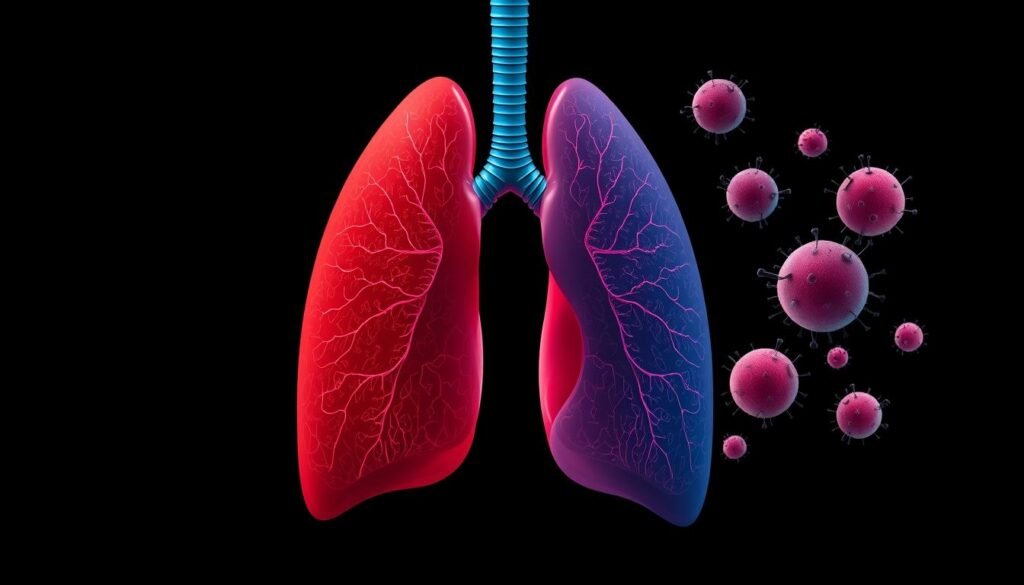Did you know that approximately 53% of lung cancer cases are already spread when found? This shows how quickly lung cancer can spread, making it urgent to understand metastasis. Metastasis is when cancer cells move from their original place to other body parts. Because lung cancer is so common, it’s important to know how it spreads. This helps us understand what affects a patient’s chance of recovery.
It’s key to understand metastasis to get why certain treatments work and what they mean for living with cancer. The type of lung cancer, how advanced it is when found, and a person’s overall health play big roles. Knowing about the spread of lung cancer can guide patients and caregivers through tough times.
Key Takeaways
- Over 53% of lung cancer cases have already metastasized at diagnosis.
- Small Cell Lung Cancer (SCLC) tends to spread faster than Non-Small Cell Lung Cancer (NSCLC).
- With early detection, lung cancer mortality rates could be reduced by approximately 20%.
- The overall 5-year survival rate for lung cancer is about 26.7% in the United States.
- Identifying preferential sites for metastasis is crucial for effective treatment planning.
Introduction to Lung Cancer
Lung cancer leads in cancer deaths globally, hitting different people. The lung cancer overview talks about two main types: small cell and non-small cell lung cancer. Small cell lung cancer often occurs in heavy smokers. Meanwhile, non-small cell cancer makes up 80% to 85% of cases. This group includes squamous cell carcinoma, adenocarcinoma, and large cell carcinoma.
The introduction to lung cancer points out its seriousness. It says smoking is the main cause, but non-smokers can get it too, especially from secondhand smoke. The chance of getting lung cancer goes up with how much and how long you’ve smoked. Working with harmful substances, past radiation treatments, and having lung cancer in the family also increase this risk.
The symptoms of lung cancer can be easy to ignore. They include things like breathing issues, coughing up blood, and chest pain. These signs highlight why catching the disease early is vital for better results. Quitting smoking, staying away from secondhand smoke, and living healthy can lower your lung cancer risk.
Types of Lung Cancer and Their Growth Rates
Lung cancer comes in various types, mainly Small Cell Lung Cancer and Non-Small Cell Lung Cancer. Knowing the differences between these helps us grasp their growth and treatment implications.
Small Cell Lung Cancer (SCLC)
Small Cell Lung Cancer makes up about 15% to 20% of lung cancer cases. It’s known for being very aggressive. It tends to spread quickly, often being at an advanced stage when found. SCLC usually starts in the bronchi, the big airways leading from the trachea into the lungs. Because it grows so fast, treatment needs to start quickly.
Non-Small Cell Lung Cancer (NSCLC)
Non-Small Cell Lung Cancer accounts for 80% to 85% of lung cancer cases. It includes subtypes like adenocarcinoma, squamous cell carcinoma, and large cell carcinoma. Adenocarcinoma is the most common and starts in the mucus-making cells of the airways. Squamous cell carcinoma begins in the flat cells lining the airways and usually grows near the center of the lungs.
Large cell carcinoma, another subtype, has bigger-than-normal cells seen under a microscope. Its growth rate can vary but is generally slower than SCLC’s.
It’s key to understand the different lung cancer types for better treatment plans. For more info on lung cancer types, check out this thorough resource.
Understanding Metastasis
Metastasis is a major hurdle in lung cancer treatment. It happens when cancer cells spread from the lungs to other body parts, creating new tumors. Knowing about this process is key for picking treatments and guessing the patient’s future health.
Lung cancer’s spread suggests a more serious stage, known as metastatic lung cancer. At this point, the goal is to manage symptoms, not cure the cancer. This helps make life better for the patient.
Metastasis travels via blood and lymph systems. It often reaches:
- Nearby lymph nodes
- The brain
- The bones
- The liver
- The adrenal glands
- Other parts of the lung
Every cancer survivor’s experience is unique. It’s vital to see a cancer expert for a treatment plan tailored to you.
Learning about a cancer diagnosis often leads to feelings of worry and fear. Support and clear information are crucial. They help patients handle their lung cancer journey.
Trusted guidelines, like those from the National Institute for Health and Care Excellence, offer good advice on lung cancer care. Resources and support from groups like Cancer Research UK are also helpful. They create a community of support.
How Lung Cancer Spreads Quickly
Lung cancer is known for spreading fast. This happens because it grows quickly and spreads in different ways. It’s important for both patients and doctors to understand this. They can then fight the disease better.
Methods of Cancer Spread
Lung cancer can move in several ways. It can grow into nearby areas or use the blood and lymph systems to spread. Lung cancer often moves to other parts of the body early on. In fact, 57% of patients find out they have it after it has already spread. It can reach vital areas like the liver, bones, and brain. This makes treating it harder.
Rapid Tumor Growth Characteristics
Many lung cancers grow fast. Studies show that lung cancer can double in size in about 134 days. This is faster than many other cancers. For example, some lung cancers can double in just 24 days. But not all lung cancers grow this fast. For some, it can take up to 400 days to double.
This fast growth means the cancer can become serious quickly. This affects how well a patient can recover. The type of lung cancer and the patient’s unique traits influence how fast it grows and spreads. Below is a look at how different lung cancer types grow:
| Lung Cancer Type | Average Doubling Time (Days) | Metastasis Potential |
|---|---|---|
| Small Cell Lung Cancer (SCLC) | 24 – 86 | High |
| Non-Small Cell Lung Cancer (NSCLC) | 191 – 230 | Moderate |
| Adenocarcinoma | 261 | Variable |
| Squamous Cell Carcinoma | 70 | Higher than adenocarcinoma |

Common Sites of Metastasis
It’s crucial to know where lung cancer often spreads to manage it well. Metastatic lung cancer can worsen a person’s life quality. Here are the main spots it goes to and how it affects those areas.
Liver
About 30% to 50% of people with advanced lung cancer will see it spread to their liver. The liver’s rich blood supply makes it a common target. Symptoms can be abdominal pain, jaundice, and losing weight without trying.
Bones
In 30% to 40% of advanced lung cancer cases, the bones are affected. This can make bones hurt and more likely to break. Such pain can disrupt daily life and harm one’s well-being.
Brain
Brain metastases occur in about 40% of lung cancer cases. These can cause headaches, seizures, and changes in thinking. This makes treatment more complex.
Adrenal Glands
The adrenal glands might also get cancer, but often without any symptoms at first. Though silent, these metastases can change hormone levels, subtly affecting health.
| Site of Metastasis | Occurrence (%) | Common Symptoms |
|---|---|---|
| Liver | 30% – 50% | Abdominal pain, jaundice, weight loss |
| Bones | 30% – 40% | Bone pain, fractures |
| Brain | 40% | Headaches, seizures, cognitive changes |
| Adrenal Glands | Varies | Asymptomatic |
Knowing these common metastasis sites helps in making treatment choices. It aids in planning how to manage symptoms for those with metastatic lung cancer. Realizing how lung cancer spreads showcases the need for constant watch and quick medical action.
Symptoms of Advanced Lung Cancer
It’s very important to recognize the signs of advanced lung cancer early. These signs can show the disease has spread. This spread makes treatment more complex. General signs help doctors understand the patient’s condition better. This understanding can help them make treatment decisions.
General Symptoms to Watch For
People with advanced lung cancer often show certain symptoms. These symptoms tend to get worse as the disease advances. Here are some common signs of advanced lung cancer:
- Persistent cough, which may worsen over time
- Coughing up blood, a concerning sign that requires medical evaluation
- Chest pain, which might be related to lung involvement
- Hoarseness, often due to vocal cord involvement
- Loss of appetite and subsequent weight loss
- Shortness of breath, indicating possible lung obstruction or fluid accumulation
- Fatigue and decreased energy levels, common in advanced stages
- Recurrent respiratory infections that may indicate compromised lung function
- Wheezing, which can occur from airway obstruction
Specific Symptoms Linked to Metastatic Spread
As advanced lung cancer spreads, it can reach other organs. Depending on where it spreads, the symptoms can differ a lot:
| Metastasis Site | Symptoms |
|---|---|
| Liver | Abdominal pain, fatigue, nausea, and jaicundice |
| Bones | Severe pain and increased risk of fractures |
| Brain | Neurological symptoms, including headaches and changes in vision |
| Adrenal Glands | May show no symptoms; large tumors can cause back or abdominal pain |
| Lymph Nodes | Swelling in the armpit, neck, or stomach, indicating possible metastasis |
Understanding these symptoms is crucial. Advanced lung cancer brings many challenges. Detecting these signs early can lead to better treatment options. This can help improve the quality of life for patients.
Lung Cancer Stages and Their Impact
The lung cancer stages guide treatment choices and affect patient outcomes. Non-small cell lung cancer (NSCLC) is categorized from I to IV. Each stage shows how much the cancer has spread. Stage 0 is early-stage cancer confined to the lungs’ surface or bronchus. This stage allows for more effective treatment options. On the other side, small cell lung cancer (SCLC) has two main stages: limited and extensive. These stages show the cancer’s progression.
To understand the lung cancer impact, we look at the TNM classification. It assesses tumor size, location (T), lymph node involvement (N), and metastasis status (M). This system helps create tailored treatment plans. Correct staging is crucial to pick the best treatment based on the cancer’s type and stage.
Techniques like mediastinoscopy or EBUS-TBNA help evaluate lymph node involvement before treatment. After surgery, pathological staging adds clinical findings to surgical results. This gives a more precise cancer stage. This approach ensures patients get treatment that suits their situation best. It helps improve their prognosis and potential survival rates.
| Stage | Description | 5-Year Survival Rate |
|---|---|---|
| Localized (Stage I) | Cancer confined to the lung | 62.8% |
| Regional (Stage II & III) | Cancer spread to nearby lymph nodes | 34.8% |
| Distant (Stage IV) | Cancer has metastasized to other organs | 8% |
Statistics show that patients with lung cancer stages I or II often have better outcomes than those at advanced stages. Early detection is key. It leads to better treatment success and higher survival rates.
Risk Factors for Aggressive Lung Cancer
It’s vital to know the risk factors for lung cancer. This knowledge helps in preventing and catching it early. Particularly, non-small cell lung cancer (NSCLC) is a major health threat. Understanding what leads to its development could improve how we prevent it.
Smoking and Environmental Factors
Smoking is the top reason people get lung cancer. Astonishingly, 85% of those with lung cancer smoked before. The damage smoking does to lungs is massive, leading to 80% of all lung cancer deaths. Elements like air pollution and exposure to radon and asbestos also play a role. Radon alone causes about 10% of the cases. These risks, together with smoking, underline the importance of more research.
Genetic Predispositions
Genes are also key in lung cancer risk. Specific gene mutations increase the chance of getting aggressive lung cancer. Having a family history of lung cancer might mean a higher risk. Knowing one’s family health history can lead to early detection. For in-depth info, check out risk factors for lung cancer.

| Risk Factor | Impact on Lung Cancer |
|---|---|
| Smoking | Leading cause; contributes to 85% of cases |
| Radon | Second leading cause; 10% of lung cancers |
| Asbestos Exposure | Linked to increased lung cancer risk |
| Genetic Mutations | Increased likelihood of adenocarcinoma |
Treatment Options for Metastatic Lung Cancer
Each patient with metastatic lung cancer needs a special plan made just for them. Thanks to new therapies, people with lung cancer are living longer than before. Knowing the treatments helps people fight this tough disease better.
Surgery
If the cancer hasn’t spread much, surgery might work. This is for when it’s in only a few places. But, if the cancer has gone beyond the lung, surgery might not help.
Chemotherapy and Radiation Therapy
Chemotherapy attacks cancer cells that grow fast, anywhere in the body. Radiation therapy also plays a big part, especially for advanced cancer. It can ease symptoms and make life better.
Techniques like SBRT are precise. They target tumors directly, with short but strong radiation doses. Here’s a good guide for more on radiation therapy.
Targeted Drug Therapy and Immunotherapy
Targeted therapies attack cancer’s specific genes. This makes treatments more effective and reduces side effects. Immunotherapy strengthens the body’s cancer fight. With constant research, like at UChicago Medicine, new drugs are coming.
Survival Rates of Metastatic Lung Cancer
The survival rates for metastatic lung cancer differ widely. This is due to many factors. Knowing these stats can show what to expect with this aggressive cancer. There’s a big difference in survival between types of lung cancer, like small cell lung cancer (SCLC) and non-small cell lung cancer (NSCLC).
Statistical Overview
People with extensive-stage SCLC have a five-year survival rate of only 3%. Those with metastatic NSCLC do slightly better, with about 8% surviving five years. A distressing 25 to 30% of metastatic NSCLC patients live less than three months post-diagnosis. The overall five-year survival rate for lung cancer is about 18.6%. These figures show the harsh truth: lung cancer is the top killer among cancers, causing 25% of all cancer deaths.
Factors Influencing Survival Rates
Several factors impact the survival rates for metastatic lung cancer, including:
- Age: Lung cancer is mostly found in those 65 and older, with an average diagnosis age of 70.
- Overall Health: How healthy a patient is overall, including past medical issues, can change outcomes a lot.
- Tumor Biology: The unique makeup of the tumor, such as genetic changes, is key.
- Treatment Regimens: The success of treatments like chemo or targeted therapy also matters.
Understanding these factors shows why tailored treatments are crucial for those fighting metastatic lung cancer.

Importance of Early Detection
Finding lung cancer early is key to better treatment results and longer lives. Lung cancer causes the most cancer deaths in the U.S. So, it’s vital to catch it early. Low-dose CT (LDCT) scans are important for finding lung cancer when it’s still easy to treat.
Benefits of Early Diagnosis
Being proactive about your health has several benefits:
- Better treatment options: Early detection means less aggressive treatments and better outcomes.
- Improved quality of life: Early care lets patients keep doing their daily activities and stay well during treatment.
- Higher survival rates: Only 21% of lung cancers are caught early, but finding them sooner can greatly improve this number.
The American Cancer Society advises yearly LDCT screening for people 50 to 80 who smoked a lot. This early check-up can catch cancer sooner and lower the risk of dying from lung cancer. There are risks and costs with screening, but talking with doctors helps. They consider your personal risk before suggesting these tests.
Conclusion
Lung cancer is a major health issue, with someone diagnosed every two minutes in the U.S. It spreads fast and affects not just patients but their families too. Over 361 people die from it each day, making fast action key.
The five-year survival rate has gone up to 28.4%. But we must keep fighting this tough disease.
Early detection makes a big difference. Yet, only 16.0% of people who should get checked actually did in 2022. Low-dose CT scans could cut death rates by 20%. This shows why it’s crucial to push for screenings.
Doing more screenings could save many lives and even save up to $500 million later.
To stop lung cancer, we need to tell people about how it works, the risks, and how to treat it. By stressing the need for early screenings and action, we can change the fight against this widespread problem.